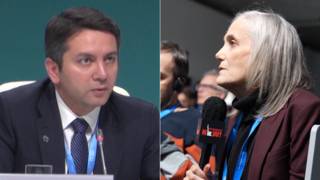
Related
Topics
Guests
- Kai Wrightfreelance journalist. His latest article for The Nation is called “Subprime Swindle.” It traces the impact of the mortgage crisis on the black middle class.
A landmark study developed by Demos and Brandeis University finds that three-out-of-four African American and four-out-of-five Latino middle-class families are on shaky financial ground. This marks the first comprehensive report to examine economic stability of households of color in this country. [includes rush transcript]
Transcript
JUAN GONZALEZ: We want to talk about the vast majority of African American and Latino middle-class families that are at risk of falling out of the middle class altogether. Only one-in-four African Americans and one-in-five Latino middle-class families in America are financially secure. That’s according to a new report by the policy center Demos and the Institute for Assets and Social Policy at Brandeis University. It’s called “Economic (In)Security: The Experience of the African American and Latino Middle Classes” and is the first comprehensive report to examine economic stability of households of color in this country. The report measures financial security by rating assets, educational achievements, healthcare costs, budgets and housing costs.
To find out more, we’re joined here in our firehouse studio by Jennifer Wheary. She’s a senior fellow at Demos and one of the co-authors of the report. And journalist Kai Wright, who’s also still with us, his latest article for The Nation is called “Subprime Swindle.” It traces the impact of the mortgage crisis on the black middle class.
Welcome to Democracy Now!
JENNIFER WHEARY: Thank you.
JUAN GONZALEZ: Jennifer, could you tell us some of the main findings, especially in terms of the indicators that you used to judge the security of the black and Latino middle classes?
JENNIFER WHEARY: Sure. What we wanted to do in this report was to look at — to define the middle class not just as a construct of income or of occupation, which is the way it’s usually defined, but as a lifestyle or of a certain amount of security and stability in your life, you know, like being able to meet your expenses today, to develop a nest egg for tomorrow, put your kids through school and so forth. And to do that, we looked at the factors that you outlined.
And what we found was when we compared the situation of white middle-class families to African Americans and Latinos, there were vast differences. You know, and what was astounding to us was really looking at — these are, you know, African American and Latino families that, by all sense and purposes, have achieved the American dream, people who, you know, have two earners, two professional earners in the household, you know, maybe are trying to own a home or do own a home, you know, very — have achieved all the aspirations that we typically go for. But even among those people, when you look at, you know, where they’re weak economically, we found that about two-in-five Latino middle-class families are in danger of falling out of the middle class. They’re so financially vulnerable, don’t have assets. Maybe somebody in the household is uninsured. And one-in-three African American middle-class families are also in danger, so vulnerable, so weak, that they’re in danger of falling out of the middle class.
JUAN GONZALEZ: And what are the key factors of vulnerability that they face?
JENNIFER WHEARY: Assets, for us, was really astounding. We found that almost 90 percent of African American and Latino families don’t have enough assets to cover just — not even all, but just the majority of their essential expenses for even three months, you know, if they had to live on those assets alone, in case of a job loss or some other sort of unforeseen crisis. And for us, that’s an area of extreme, extreme vulnerability and extreme concern, because that’s really — the importance of assets is something that allows families to, again, weather current crises, but then also plan for the future and also give future generations a good start.
JUAN GONZALEZ: I think one of the things that I noted in the report was how much of whatever assets African Americans and Latinos have are tied up with whatever equity they have in their homes, as opposed to any other kind of assets, whether it’s cash in the bank or stocks or bonds or whatever, but that essentially the wealth that exists in black and Latino America is basically the wealth in the equity of their houses, right?
JENNIFER WHEARY: Right, right. One of the stats that I’ve heard is, about two-thirds of the wealth of African American and Latinos are tied up in their homes. And, you know, when we put this report out, when we looked at the net worth that people had, this was — the data that we had to use was before the subprime meltdown and the things that are going on now. And so, it’s really interesting to us, but also frightening, to get to the point where we’ll be able to take a look that really incorporates the recent meltdown.
JUAN GONZALEZ: Well, and that, Kai, is a good segue to you, because you’ve been writing about the meltdown and its impact on African Americans and Latinos. And it’s been basically devastating across the country to especially, quote, “middle-class” communities, hasn’t it?
KAI WRIGHT: Well, I mean, one thing to note about subprimes is it didn’t matter what income you were. At low income, middle income and high income, African Americans and Latinos were two and three times more likely to get a subprime loan. And as we know from the Wall Street Journal’s reporting, many of them also would have qualified for prime loans but were steered into it.
And it is really quite depressing and concerning what is going to happen in the future because of how much of home equity is — how much wealth is dependent upon home equity. As our communities get hit with these foreclosures, it is not just a static moment. It is not just right now that that’s going to matter. This is going to echo for potentially generations of people.
And, you know, we had already sort of spent so much time clawing back through homes from the ways in which the racist — from our long and predatory history of racist lending. We’ve spent so much time clawing back from that. And now, in one fell swoop, we could very well be right back to where we were before we started, before the Community Reinvestment Act of 1977, before we started creating avenues for African Americans and Latinos and other people of color to try to get some capital. It’s really quite scary where we’re headed.
JUAN GONZALEZ: And there have been, though, repeated crises of this type that seem to feed off the abuses in home lending, because I remember in the 1970s there was a huge crisis of FHA-backed mortgages that basically left many areas of the inner city with thousands and thousands of abandoned houses. Again, predatory lenders, at that time, was abusing FHA financing for loans, which required very little down payment, as opposed to now these refinancings of home equities. But this appears to be far deeper and, as you say, more potentially long-lasting than any of the previous crises.
KAI WRIGHT: Well, on scale. I mean, I think because it dovetailed with all the other stuff going on in the market, it reached a scale that is particularly troubling. But as you point out, predatory lending is nothing new in communities of color. This has been arguably the entirety of the history of the mortgage industry, has been — part of its business model has been predatory behavior in communities of color. And so, that’s an important thing to remember.
We now have our supposed fixed from Congress. And it’s a, you know — and it’s as good bill as far as it goes, but — and the Fed has stepped in to do some regulating of some of the abuses that went on with the subprime loans. But this is abuse that must be constantly watched, because you can bet that the next time there’s a dime to be made on preying on these communities, that lenders will do it again. And so, we’re going to have to stay vigilant.
JUAN GONZALEZ: And, Jennifer Wheary, I’d like to ask you also about the healthcare aspect of the indicators that you use. Obviously, the healthcare crisis continues to expand in terms of the number of people that are not insured. How has this affected the African American and Latino communities in terms of their economic stability?
JENNIFER WHEARY: That’s been one of the factors that we looked at, because if a family has even one member uninsured, if something happens to that person, all of a sudden the family’s resources, which, you know, as we talked about, are very limited, their assets are going to be drawn into helping that person. And we found that one-in-three, almost one-in-three, African American families have at least one family member that’s uninsured. And for Latino families, I believe it’s two-out-of-five families. And for us, again, these are —-
JUAN GONZALEZ: And compared to the average white family, what’s the -—
JENNIFER WHEARY: Average white family, about 20 percent. So there’s still, you know, a substantial amount of white families, but again, if you look at the disproportionate nature of things, it’s incredibly troublesome.
JUAN GONZALEZ: And in terms of the possible solutions that you offer in terms of assuring better stability among these — those who have managed to progress to a certain level?
JENNIFER WHEARY: Mm-hmm. Well, I mean, as Kai said, I think that looking at predatory lending is absolutely essential. It’s — the housing crisis and what’s happening with mortgages is a — not to put too much of a pun out there — but it’s a prime example. But additionally, there are other aspects of lending. I mean, there’s payday loans in neighborhoods. And there’s also, I think, the credit card sector we have to look at, as well. We have another report out, which looks at the fact that high-cost credit cards are really targeted and disproportionately held by African American and Latino families.
JUAN GONZALEZ: And Kai, your sense of what could be some of the policy decisions that would help in this area of providing more security for those middle-class families?
KAI WRIGHT: Well, I mean, quickly, to piggyback on what Jennifer said, I mean, one of the interesting things about the subprime loans and getting people into them was that there was — that a lot of the folks were being targeted, saying, “Hey, look. You’ve got all this credit card debt,” which they got from predatory behavior, “You should roll that over into — you should borrow against your home to pay that off.” So, one builds upon the next builds upon the next. Now, if you drive around neighborhoods where there’s lots of foreclosures, you see an eruption of all of these folks who put up fliers and say, “Hey, are you in trouble? Come to us. We’ll buy up your house real quick,” you know.
JUAN GONZALEZ: So there’s a new predatory wave on top of all the others, taking advantage of the new situation.
KAI WRIGHT: They just build one upon another. Arguably, the subprime stuff came out of, you know, I mean, the reaction — the Community Reinvestment Act demanded that banks start lending in these neighborhoods. They immediately came up with ways to do it in a predatory way. You know, so it’s one flows from the next.
So, solutions? One, we have to not assume that because we pass some regulations this week that we’re done with this problem and we can go back to our business. Two, you know, there’s — this bill is going to help 400,000 people; there are — maybe 400,000 people — there are something like two million barreling towards foreclosure. A huge number of those are African American, Latino. African Americans and Latinos are expected to absorb about half the nation’s loss from this. So something’s going to have to happen to the families that are still coming. So we’re not done with figuring out how to stop the bleeding.
JUAN GONZALEZ: And I’ve been surprised — we’ve got about thirty seconds — at how little at the local leadership level, political leaders, how slowly they have moved, even though they’ve been recognizing this now for more than two years, how slowly they’ve moved on trying to come up with fixes at the state levels or to deal with some of this, especially with the subprime crisis. Any thoughts on that?
JENNIFER WHEARY: I think that there’s been a lot of activities sort of playing a bit of a shell game about who’s to blame for these things. But now we have so many pieces of bad news converging that, you know, local leaders really need to step back and take a look and take action.
JUAN GONZALEZ: OK. Well, I want to thank both of you very much for being with us. Kai Wright, he’s a Brooklyn-based journalist. His latest piece for The Nation magazine is titled “The Subprime Swindle.” Jennifer Wheary is a senior fellow with Demos and co-author of a new report called “Economic (In)Security: The Experience of the African American and Latino Middle Classes.”












Media Options